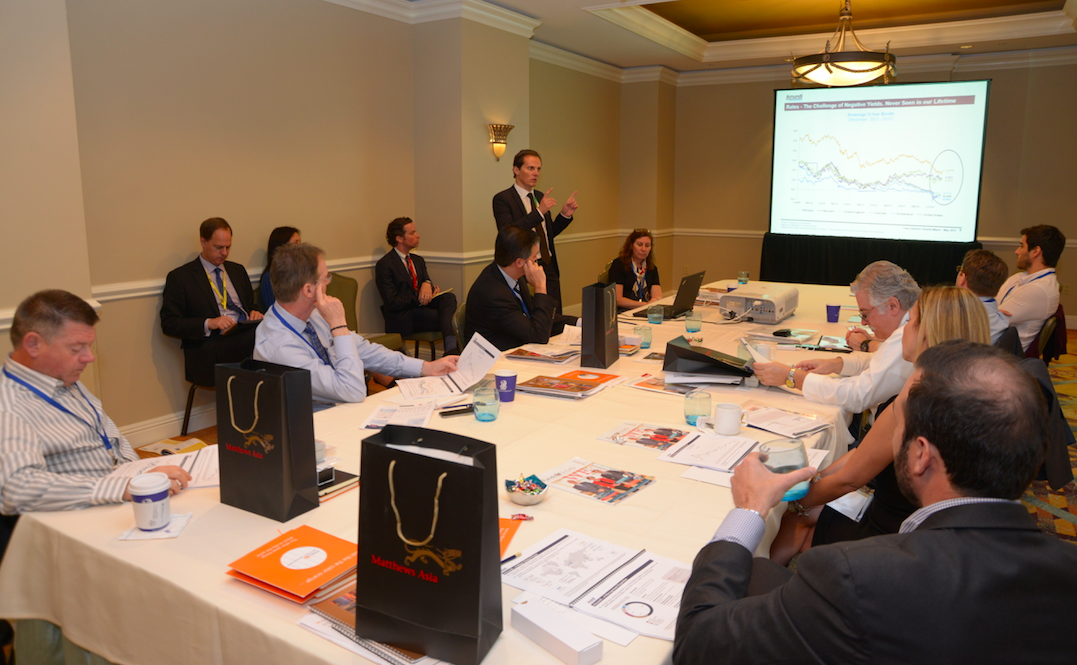The Fund Selector Summit, which was held in Miami on the 7th and 8th of May and organized by Funds Society and Open Door Media, started its first day with the participation of five asset management companies, whose professionals offered interesting solutions to deal with a challenging backdrop of uncertainty in the markets.
Maria Municchi, Investment Specialist in Multi Asset and Convertibles Strategies at M&G Investments, explained the different perspective they apply to the M&G Dynamic Allocation Fund when investing in multi-assets, which is based on a strategic perspective (valuations and fundamentals), tactics (understanding the reasons for the volatility, whether it is due to fundamentals or to investor behavior, and taking advantage of it), and the construction of portfolios analyzing and contextualizing the current correlations in the markets. While remaining aware at all times that making predictions about the markets “may lead to dangerous ground, because the opposite may occur.”
M&G is currently positive with equities, especially European and Japanese, and with the dollar (although they’ve reduced exposure) and they advocate for flexibility on fixed income to adopt relative value positions. Convertibles and real estate also bring diversification to the portfolio. The expert pointed out the recent launch of a similar but more prudent fund, M&G Prudent Allocation.
Sunil Asnani, Senior Manager of the Indian equities fund at Mathews Asia, focused on rejecting arguments which recently explained the great interest in the asset class, and advocated for getting into the country’s equity for the good reasons rather than for the bad. In his opinion, investing for the expectations that the asset will generate diversification (when in fact it is closely related to other markets), for the desire for a short-term gamble (with all the associated risks); for the good macro situation which the country is currently experiencing (even though it’s very difficult to predict what will happen in the future), or trying to invest in firms which grow faster or are thematic investments (when they aren’t necessarily the best options) is an erroneous perspective.
“The potential for economic growth and market accessibility are good reasons to invest in India,” he said, and he defended bottom-up active management focused on company analysis and fundamentals, and always with a long-term horizon. “The problem with India is that investors are either too optimistic or too pessimistic with the asset class,” he complained.
Also on the subject of equities, Sam Shapiro, Client Portfolio Manager and member of the Quantitative Investment Strategies team at Goldman Sachs Asset Management, explained the company’s vision on the technological transformations in recent years, focusing his presentation on how to apply Big Data to the asset management industry. With three distinct ideas: Big Data and technology are transforming the world and determining the winners and losers in each sector; data itself does not provide solutions and requires the application of skills and work; and that this data can be applied not only in analyzing trends and market sentiment, but also in understanding the company better from a fundamental perspective. Therefore, he defended the good use of data by fund managers in order to improve their work, applying it to the management of equities.
Fixed Income
Opportunities are also available in fixed income. Laurent Crosnier, CIO at Amundi London, defended flexible and dynamic global asset management (across the entire spectrum of fixed income and geographies), which the management company applies to its Amundi Global Aggregate Fund. And of utmost importance in the current environment: “The worst thing for a fixed income investor is yet to come: the worst is to invest and pay a negative return,” he said, pointing out that much of the public debt universe, especially in the developed world, offers negative returns or returns of less than 1%.
This is why he advocated for solutions to avoid “paying to invest”, which their company is trying to achieve with very active and flexible investment strategies. Within the current environment, he is positive with credit (preferably European and with an overweighting in the financial sector), negative with the duration due to the next interest rate hike (although preferring European government debt over German, so as “not to fight the ECB”), positive with the dollar and the pound against other currencies like the yen and the euro, and also possitive in some emerging markets, such as Mexico and Brazil, versus the commodity currencies. Regarding emerging debt, he defends the need to be selective, with some commitments in countries like Brazil, Mexico, or South Africa.
Also within fixed income, Jeff Bakalar, Managing Director and Senior Loan Group Head at Voya Investment Management (formerly ING US Investment Management), focused on the opportunity offered by senior loans in an environment of rising interest rates. “In an environment of rising interest rates, even if these are minor or gradual, having this asset in the portfolio is a good idea,” he defended. Partly due to the stability offered in returns but also due to its attractive profitability when compared to other assets such as high yield debt and noting that it can offer a competitive reward-to-risk ratio.

